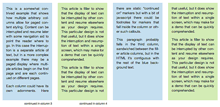I’ve been looking with interest at “CSS Regions,” Adobe’s entry into the arena of flexible page design on the web. This is clearly the sanguinary bleeding edge of onscreen design today – designing intelligent layouts that will behave differently (but coherently) under different circumstances, most notably on screens or in windows of different sizes and shapes.
Adobe Labs has released an experimental WebKit-based web browser, as a platform for showing off what CSS Regions can do. The demonstrations are mostly about shapes: they include multiple columns, arbitrarily shaped text blocks, text that flows from one text block to any other text block on the page, and a couple of other, more specific tricks. In the demos, text wraps neatly around images or around other text, in a highly flexible manner.
It’s good to see these problems being tackled. But there’s something missing. As an earlier Wedmonkey article about this technology put it, “when it comes to the flow of text around images, pull quotes and other block level elements, well, web typography falls apart.” CSS Regions is clearly aimed at enabling design with these “block level elements.” But that’s only macro-level typography; what about the typography of the text that’s doing all that wrapping? We need the same level of control over text typography on the web that we’ve got today on the printed page. And not just in an inflexible page created in InDesign and turned into a static PDF.
More tools, please.


